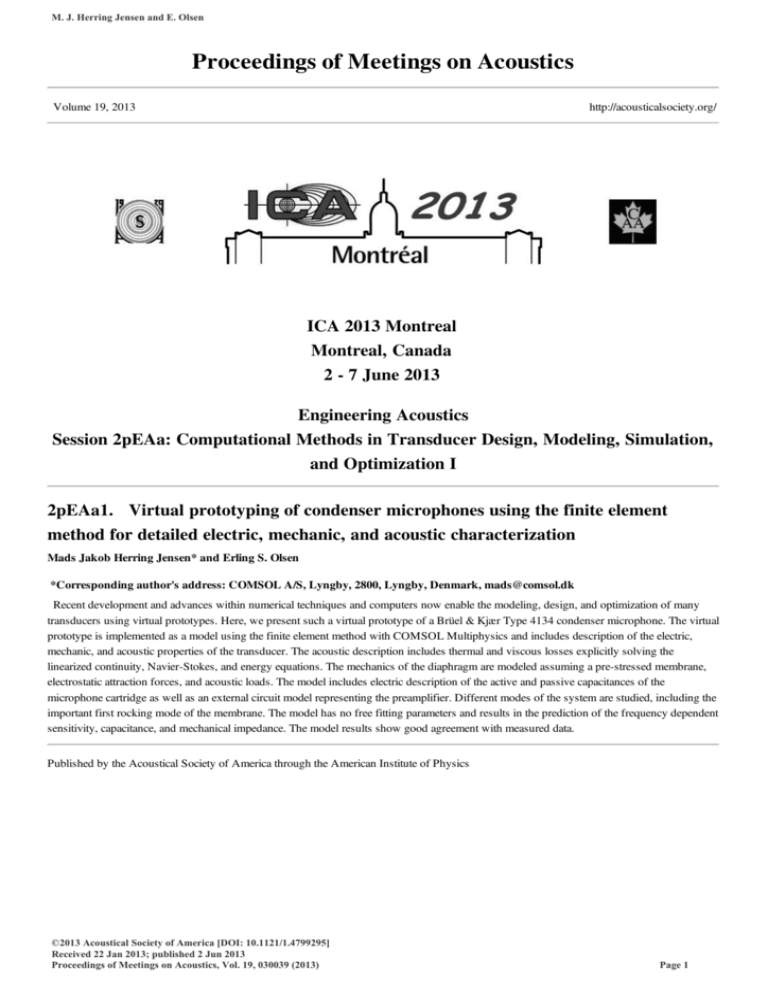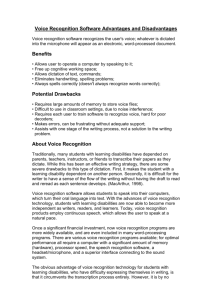2pEAa1 - ICA 2013 Montreal
advertisement

M. J. Herring Jensen and E. Olsen Proceedings of Meetings on Acoustics Volume 19, 2013 http://acousticalsociety.org/ ICA 2013 Montreal Montreal, Canada 2 - 7 June 2013 Engineering Acoustics Session 2pEAa: Computational Methods in Transducer Design, Modeling, Simulation, and Optimization I 2pEAa1. Virtual prototyping of condenser microphones using the finite element method for detailed electric, mechanic, and acoustic characterization Mads Jakob Herring Jensen* and Erling S. Olsen *Corresponding author's address: COMSOL A/S, Lyngby, 2800, Lyngby, Denmark, mads@comsol.dk Recent development and advances within numerical techniques and computers now enable the modeling, design, and optimization of many transducers using virtual prototypes. Here, we present such a virtual prototype of a Brüel & Kjær Type 4134 condenser microphone. The virtual prototype is implemented as a model using the finite element method with COMSOL Multiphysics and includes description of the electric, mechanic, and acoustic properties of the transducer. The acoustic description includes thermal and viscous losses explicitly solving the linearized continuity, Navier-Stokes, and energy equations. The mechanics of the diaphragm are modeled assuming a pre-stressed membrane, electrostatic attraction forces, and acoustic loads. The model includes electric description of the active and passive capacitances of the microphone cartridge as well as an external circuit model representing the preamplifier. Different modes of the system are studied, including the important first rocking mode of the membrane. The model has no free fitting parameters and results in the prediction of the frequency dependent sensitivity, capacitance, and mechanical impedance. The model results show good agreement with measured data. Published by the Acoustical Society of America through the American Institute of Physics © 2013 Acoustical Society of America [DOI: 10.1121/1.4799295] Received 22 Jan 2013; published 2 Jun 2013 Proceedings of Meetings on Acoustics, Vol. 19, 030039 (2013) Page 1 M. J. Herring Jensen and E. Olsen INTRODUCTION During the latest decade numerical modeling has gradually found its place as a tool in transducer development. The models have evolved from rather simple lumped circuit models to being large multiphysics finite element models. The development in the use of numerical modeling can be illustrated by the development of the models used to simulate acoustical devices. For many years, microphone and coupler calculations were made with the classical lumped parameter models [12,13]. These models are indeed useful for calculation of the effect of variation of parameters, but except for very simple cases the lumped elements have to be determined more or less empirically or based on experience. The lumped parameter models are only valid when the physics are reasonably well represented in the lumped elements, and that restricts their use to low frequencies and to simple geometries. The first finite element-based models were axisymmetric microphone models based on the boundary element method [14]. The models only concerned the external acoustics around the microphones, did not include losses, and the microphone diaphragm was modeled as simple surface impedance. The models were used for approximate calculation of the ratio of free-field and pressure sensitivity and were supplementary to the lumped parameter models. The use of a circular modal expansion of the incoming field to mimic true 3D models was also possible using the axisymmetric models. Such model where used to calculate directional characteristics of the microphones and sound level meters. These models were also used to investigate the behavior of the internal field in microphones and calibration couplers [6]. The first model that included losses was a model of the IEC 711 coupler [6]. The narrow slits in the coupler were modeled with the 2D narrow gap equations of Beltman [7], whereas the acoustics of the cavities in the coupler were calculated with the finite element method. Analytical and semi-analytical models are also presented in the literature [3-5]. In the case of acoustical devices such as microphones and artificial ears, the models need to be detailed because the devices in most cases have large aspect ratios and the dimensions are so small that thermal and viscous losses play an important role. In the case of microphones, the movement of the diaphragm, the electromechanical coupling, the coupling to the external field, and viscous and thermal losses in the internal cavities all interact strongly. The subject of this paper is the demonstration of a microphone model that practically includes all the physics of a condenser microphone. The model presented is that of a Brüel and Kjær type 4134 microphone. The model is based on the finite element method and is implemented using the software COMSOL Multiphysics 4.3a [8-11]. FIGURE 1. (left) Sketch of a condenser microphone including the physical parameters and fields used to model the condenser microphone. The symbols are explained in the text. (right) Picture of an actual BK 4134 microphone including the protective grid mounted above the diaphragm. Proceedings of Meetings on Acoustics, Vol. 19, 030039 (2013) Page 2 M. J. Herring Jensen and E. Olsen METHOD Modeling a microphone is a true multiphysics problem. It involves solving a tightly coupled mechanical, electrical, and acoustical problem. It is also worth mentioning that the couplings are strong and are two-way. A sketch of the problem a condenser microphone is depicted in Figure 1 together with a picture of the actual device. The microphone can be divided into several sub-systems: The external acoustic field, the external circuit, the internal acoustics and electrostatics, and the membrane interfacing. The latter effectively couples all the physics together. The external field (p2 in Figure 1) results from the interaction between the external incident field Pin and the microphone. The incident field is here modeled as a plane wave with wave vector k. The inclusion of an external field accounts for such effects as; the microphone spatial characteristics or the pressure build up on the membrane upon oblique incidence etc. The interaction between diaphragm and the external field also accounts for the added mass effects of the air. In this study these effects are disregarded in most of the models and the external field is assumed to be constant over the microphone membrane. The external circuit is used to set up and model the external apparatus of the microphone such as the preamplifier. This result in a system of ODEs that are solved coupled to the electrostatic model (the internal electric field in the microphone). The simple circuit depicted in Figure 1 represents the simple preamplifier circuit of the microphone and consists of a DC voltage source of 200 V (polarization voltage) and the input impedance of the microphone pre-amplifier is modeled with a resistor of typical value of 15 GΩ. Inside the microphone the acoustic perturbations, to the quiescent background pressure (p0 = 1 atm.), temperature (T0 = 293K), and velocity (assumed to be zero), are described by the linearized momentum (Navier-Stokes), continuity, and energy equations. This extended set of so-called thermoacoustic equations (also known as viscothermal or thermoviscous acoustics) is necessary in order to correctly include all the losses due to viscosity and thermal conduction [9]. The momentum, continuity and energy equations are, 2 i 0u pI ( u uT ) B ( u)I 0 3 i o u 0 i( 0C pT . T0 0 p) ( T ) 0 0 (T p 0T ) (1) (2) (3) (4) where p is the pressure, u is the acoustic velocity field, T is the acoustic temperature variations, and is the acoustic density change. The material parameters are: the dynamic viscosity , the bulk or volumetric viscosity B (here assumed to be zero), the heat capacity at constant pressure Cp, the coefficient of thermal conduction , the isothermal compressibility T, and the coefficient of thermal expansion 0. In the studied frequency range, from 1 Hz to100 kHz, the viscous and thermal effects are dominant inside the acoustic boundary layer as opposed to the bulk attenuation not important in this study. The thickness of the layer is characterized by the viscous and thermal penetration depth, dv 2 0 and dt dv and Pr . Cp Pr (5) The viscous (and thermal) thickness is comparable to the microphone dimensions at low frequencies, and at all high frequencies, to the air gap between the diaphragm and the backplate which is about 18 µm. At 1 Hz dv = 2.2 mm, at 100 Hz it is 220 µm, at 10 kHz it is 22 µm, and at 100 kHz it is 7 µm. The losses inside the acoustic boundary layer are due to viscous friction (no slip at the boundary) and large gradients of the temperature (transition from an adiabatic bulk region to being isothermal at the wall). Without the losses the microphone model would not be correct. The membrane vibrations would not be damped and the transition to isothermal behavior at low frequencies would not be well described. At hard walls the no-slip condition is used and the temperature field is assumed to be equal to zero. The latter corresponds to an isothermal condition (thermal conduction is much higher in a solid). At the vent hole (see Figure 1) the pressure is set equal to Pvent, depending on configuration. Proceedings of Meetings on Acoustics, Vol. 19, 030039 (2013) Page 3 M. J. Herring Jensen and E. Olsen The electric field inside the microphone is determined in a quasi-stationary manner (the timescales of variations in the electric fields are much smaller than the studied acoustic frequencies). The field is described requiring charge conservation and solves for the electric potential V. At the boundaries the electric field is grounded on the backplate and it is connected to a terminal on the housing, which in turn is connected to the small electrical circuit. The terminal further allows for the calculation of the lumped electric parameters of the microphone (voltage, capacitance, and charge) [10]. The diaphragm is modeled using a pure membrane model, that is, shell without any bending stiffness (a plane stress element) [11]. It is characterized bye the displacement field um. An initial stress is added to the membrane model representing the tension Tm of the microphone diaphragm (3160 N/m). The acoustic, electric and mechanical models are coupled at the membrane. The electric field induces an electrostatic attraction force which yields a surface stress given by the Maxwell stress tensor (acting on the membrane model). The bending of the membrane changes the geometry of the capacitor and thus the capacitance of the system. Finally, there is continuity of the displacement field at the membrane, that is, iu m u (6) where multiplication with iin the frequency domain, corresponds to a time differentiation. The equations are solved fully coupled using the finite element method [8-11]. The equations are solved as a frequency dependent linear perturbation to a static field. The static field stems from the pre-polarization of the microphone, resulting in a static deflection of the diaphragm. This deflection is included in the model using a moving mesh strategy that deforms the geometry. The initial stress of the membrane is also included in the static step. The frequency response now corresponds to a small linear perturbation around the quiescent static solution (the linearization point of the study). In this study two modes have been constructed. One represents only 1/12 of the total microphone geometry, here after, called the sector geometry, and one models the full 3D geometry of the microphone. The geometry and a mesh of the sector are depicted in Figure 2. The simplified sector geometry is used for all studies where symmetry is assured as it is computationally less costly (for normal acoustic incidence and capacitance estimates). The full geometry is used when, for example, studying oblique incidence on the diaphragm. FIGURE 2. Geometry plot of the BK 4134 condenser microphone. The figure shows the mesh of the sector used in the reduced sector geometry, representing 1/12 of the total geometry. Proceedings of Meetings on Acoustics, Vol. 19, 030039 (2013) Page 4 M. J. Herring Jensen and E. Olsen RESULTS AND DISCUSSION The model of the microphone is used to demonstrate that it is possible to make a virtual prototype of a microphone that has no free parameters. The finite element model is used to first characterize the response of the microphone for a normal incident external field. Several vent configurations are used combined with different input impedances of the preamplifier. The vent is either inside (exposed to) the external sound field (Pvent = Pin), outside field (unexposed to) the external sound (Pvent = 0 Pa), or it is removed and the microphone has no vent (this last configuration is not used in practice). The interaction between the vent configuration and the input resistance results in different low frequency behaviors. It is also at these low frequencies where the complex transition from bulk adiabatic to bulk isothermal behavior happens inside the microphone. The capacitance of the microphone is also modeled by adding an external current source to the small electric circuit. 2 0 Response, dB -2 -4 -6 -8 Vent outside sound field, 100 GΩ -10 Measured response -12 1 10 100 1000 10000 100000 Frequeny, Hz FIGURE 3. Frequency response of the microphone model calculated with the sector model and with the vent outside the sound field and 100 GΩ preamplifier input impedance. Also shown is a typical response of a real microphone of equivalent type measured with the reciprocity technique. In the first results Figure 3 the response of the microphone with the vent outside the sound field is compared to measured data. The data show good agreement. In Figure 4 the difference in the low frequency behavior of the response is studied for different vent configurations. The input impedance is set to 100 G in order to mainly see the acoustic phenomena and not the electric cut-off. In the no-vent configuration the sensitivity increase is due to the fact that the sound field becomes purely isothermal inside the microphone at very low frequencies. In the vent outside the sound field configuration the curve initially follows the no-vent curve. At low enough frequencies the sound field is “short circuited” resulting in pure membrane stiffness controlled behavior. In the in sound field mode the same pressure is recovered on both sides if the membrane (at low frequencies) resulting in the roll-off and loss of sensitivity. In the next Figure 5, the influence the input impedance has on the low frequency behavior is depicted for the vent in sound field configuration. It is here clear to see how the decreasing input resistance, of the preamplifier, influences the low frequency roll off. At low resistances the behavior is dominated by the electrical cut-off while for increasing resistance the behavior can be understood as the interaction of the first order filters. Proceedings of Meetings on Acoustics, Vol. 19, 030039 (2013) Page 5 M. J. Herring Jensen and E. Olsen 1 0.5 0 Response, dB -0.5 -1 -1.5 -2 -2.5 -3 No vent, 100 GΩ Vent in sound field, 100 GΩ Vent outside sound field, 100 GΩ -3.5 -4 1 10 100 1000 Frequeny, Hz FIGURE 4. Low frequency response of the microphone model calculated with the sector model and with no vent, the vent in the sound field, and with the vent outside the sound field, all with 100 GΩ preamplifier input impedance. Note the expanded ordinate axis. 2 0 Response, dB -2 -4 -6 -8 Vent in sound field, 100 GΩ Vent in sound field, 15 GΩ Vent in sound field, 8.3 GΩ Vent in sound field, 1.25 GΩ -10 -12 1 10 100 1000 Frequeny, Hz FIGURE 5. Low frequency response of the microphone model calculated with the sector model and with the vent exposed to the sound field with four different preamplifier input impedances. Proceedings of Meetings on Acoustics, Vol. 19, 030039 (2013) Page 6 M. J. Herring Jensen and E. Olsen 20 Static, Vp = 200 V Haramonic, Vp = 200 V Static, Vp = 10 V Haramonic, Vp = 10 V 19.8 19.6 Capacitance, pF 19.4 19.2 19 18.8 18.6 18.4 18.2 18 1 10 100 1000 10000 100000 Frequeny, Hz FIGURE 6. Capacitance of the microphone model calculated with the sector model with the vent outside the sound field and with 10 V and 200 V polarization voltages. Both the static and the harmonic solutions are shown. The static solution corresponds to the blocked diaphragm capacitance. The capacitance of the microphone is depicted in Figure 6. The characteristic behavior is here recovered with a near constant value below the resonance frequency and a decrease to the static capacitance after the resonance. A value range from 18.8 pF to 19.3 pF corresponds to common measured values [1,2]. The acoustic temperature variations inside a section of the microphone are depicted in Figure 8 (left) for a frequency of 500 Hz. The thermal boundary layer is clear visible showing the transition from adiabatic to isothermal behavior. The static electric potential inside the microphone is depicted in Figure 8 (right) when pre-polarized to a voltage of 200 V. FIGURE 8. (left) Temperature filed inside the microphone at 500 Hz, the thermal boundary layer is clearly visible. (right) The static electric potential distribution inside the microphone. Proceedings of Meetings on Acoustics, Vol. 19, 030039 (2013) Page 7 M. J. Herring Jensen and E. Olsen FIGURE 8. Illustration of detailed analysis with the full 3D model. (left) Representation of the sound pressure level below the diaphragm for non-normal incidence. (right) The membrane deformation for this same configuration, both evaluated at f = 25 kHz. Finally, the full 3D model is illustrated in Figure 8 where the outside field is incident at an oblique angle on the membrane. The results are given at a relatively high frequency of 25 kHz where the wavelength is comparable to the diaphragm diameter. The figure on the left illustrates the skew sound pressure level distribution below the diaphragm while the figure on the right shows the diaphragm deformation. CONCLUSIONS A detailed finite element model of a Brüel and Kjær type 4134 microphone is presented and used to illustrate the possibility to create virtual prototypes of a condenser microphone. The model is a true multiphysics problem that couples acoustics, mechanics, and electrostatics. It is implemented using the software COMSOL Multiphysics 4.3a. The model results are compared to measurements and show good agreement. The interesting low frequency behavior of the response is studied as function of different vent configurations and pre-amplifier output impedances. Finally, full 3D results are shown to illustrate the necessity of 3D models for non-ideal normal incidence of the external field. REFERENCES 1. Brüel & Kjær, “Condenser Microphones and Microphone Preamplifiers for acoustic measurements”, Data Handbook be0089 (1982). 2. Brüel & Kjær, “Microphone Handbook, Vol. 1: Theory”, Technical Documentation be1447 (1996). 3. D. Homentcovschi and R. N. Miles, “An analytical-numerical method for determining the mechanical response of a condenser microphone”, J. Acoust. Soc. Am., 130, pp. 3698 (2011) 4. T. Lavergne, S. Durand, M. Bruneau, N. Joly, and D. Rodrigues, “Dynamic behavior of the circular membrane of an electrostatic microphone: Effect of holes in the backing electrode”, J. Acoust. Soc. Am., 128, pp. 3459 (2010). 5. A. J. Zuckerwar, “Theoretical response of condenser microphones,” J. Acoust. Soc. Am., 64, pp. 1278 (1978). 6. B.L. Zhang, S. Jønsson, A. Schuhmacher, and L.B. Nielsen, “A combined BEM/FEM Acoustic Model of an Occluded Ear Simulator”, InterNoise 2004, Prague, Czech Republic (2004). 7. W. M. Beltman, P. J. M. Van Der Hoogt, R. M. E. J. Spiering, and H. Tijdeman, “Implementation and Experimental Validation of a New Viscothermal Acoustic Finite Element for Acousto-Elastic Problems”, J. of Sound and Vibration, 216, pp, 159 (1998). 8. COMSOL Multiphysics, version 4.3a, www.comsol.com (2013). 9. COMSOL Acoustics Module, www.comsol.com/products/acoustics (2013). 10. COMSOL AC/DC Module, www.comsol.com/products/acdc (2013). 11. COMSOL Structural-Mechanics Module, www.comsol.com/products/structural-mechanics (2013). Proceedings of Meetings on Acoustics, Vol. 19, 030039 (2013) Page 8 M. J. Herring Jensen and E. Olsen 12. L. L. Beranek, “Acoustics”, J. Acoust. Soc. Am., Part XIII, Acoustic Elements, (1996). 13. W. Marshall Leach, Jr., “Introduction to Electroacoustics and Audio Amplifier Design”, 3rd edition, Kendall/Hunt Publishing Company (2003). 14. V.C. Henriquez, “Numerical Transducer Modeling”, PhD Thesis, DTU, November (2001). Proceedings of Meetings on Acoustics, Vol. 19, 030039 (2013) Page 9





